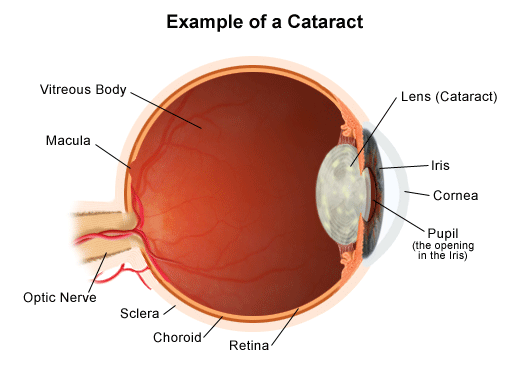Cataracts
A Natural Effect of Aging

The eye's natural crystalline lens helps us focus on people and things at varying distances. Unfortunately, as we grow older this lens often stiffens and hardens, and without its youthful suppleness, it loses its ability to focus, creating vision problems. This condition — for most, a natural consequence of aging — is called presbyopia.
As we age, these changes occurring to the natural crystalline lens can lead to the development of cataracts, or a loss in clarity of the lens.
Since the lens is no longer as flexible or as clear as it used to be, the eye can't focus light properly, causing the following symptoms:
- Cloudy or blurred vision
- Sensitivity to light and glare
- Poor night vision
- Fading color
- Frequent changes in glasses prescription
By age 65, many of us will develop a cataract.
Improving Your Vision
Developing a cataract doesn't mean a permanent loss of vision quality, or having to give up the things you love, because cataract surgery is a safe, effective way to improve your vision. Cataract surgery is the most commonly performed surgery in the United States, with well over 2 million Americans having the procedure every year. Usually performed on an out-patient basis, cataract surgery is microsurgery, whereby the natural lens is removed and replaced with what is called an intraocular lens (IOL). The procedure is highly successful and most people regain very good distance vision.
High Technology IOLs
Artificial intraocular lenses, or IOLs, replace the eye's natural lens that is removed during cataract surgery. IOLs have been around since the mid-1960s, though the first FDA approval for one occurred in 1981. Before that, if you had cataracts removed, you had to wear very thick eyeglasses or special contact lenses in order to see afterward, since the natural lens that had been removed wasn't replaced with an artificial one.
Until recently, only cataract surgeons — not their patients — weighed the risks and benefits of various IOLs. The surgeons' discussions focused on the surgical technique (clear cornea, small incision, etc.) and the physical design of the lenses (one-piece vs. multi-piece, acrylic vs. silicone) and how that design affected insertion, positioning and healing.
Good vision after cataract surgery was another important consideration. But now that new IOLs have been introduced that solve more vision problems than ever, cataract surgeons have more to consider before choosing IOLs for their patients' visual needs. Cataract patients are becoming more involved in the choice as well.
If you or someone you know will be undergoing cataract surgery, consider your choices in the following summary of the most recently developed IOLs.
Premium IOLs: Multifocal u0026amp; Accommodating
Traditional IOLs are monofocal, meaning they offer vision at one distance only (far, intermediate or near). They definitely are an improvement over the cataractous lens that is replaced during surgery, which provides only cloudy, blurred vision at any distance. But traditional IOLs mean that you must wear eyeglasses or contact lenses in order to read, use a computer or view objects at arm’s length.
The new multifocal IOL's, the Symfony HD Multifocal, and Symfony Multifocal Toric offer the possibility of seeing well at more than one distance, without glasses or contacts. The toric IOL corrects for astigmatism.
Presbyopia or astigmatism correcting IOLs are considered “premium” lenses, which means that they are an upgrade from the standard IOL. Accordingly, there is an associated additional cost.
Because of the additional practical but not essential benefits of these IOLs, they are considered a cosmetic enhancement and not a medical necessity.
Medicare and most health care plans will cover the cost of the standard implant, so the patient is only responsible for the difference. Although there is an additional cost to these unique implants, the benefits are a permanent investment in vision. One gets the opportunity for this type of correction only once in a lifetime!
